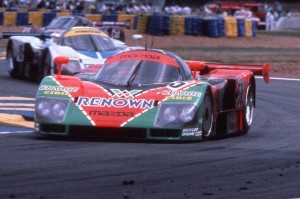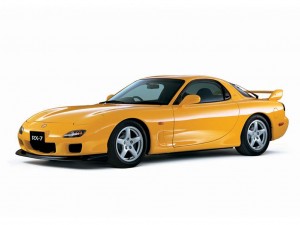With the upcoming demise of the RX-8 sports car, a piece of Mazda’s history will vanish. But a senior company engineer tells TheDetroitBureau.com that the Japanese maker aims to bring back the rotary engine – in all-new form – shortly after mid-decade.
Formally known as the Wankel, the unusual powertrain helped put Mazda on the map when it first entered the American market four decades ago. At the time, a large number of manufacturers were studying rotary engine applications. But early problems with reliability and an ongoing issue with fuel economy led most makers to abandon the technology.
Mazda, however, has maintained the rotary in its line-up because its small size and high performance fit the brand’s “zoom-zoom” image, said Kiyoshi Fujiwara, the Japanese maker’s global product design chief.

The rotary-powered Mazda 787B won an overall victory at Le Mans, in 1991, the only Japanese entry ever to take the title.
The rotary appeared to get a death sentence when Mazda announced it was pulling production of the slow-selling RX-8, a four-door sports car. No other applications appeared on the horizon reflecting, at least in part, the challenge of working with an engine known for its decidedly fuel-thirsty nature.
Senior company officials have continued to support efforts to develop a more efficient – and powerful – version of the Wankel, Fujiwara confirmed – though he also noted that the project was moved to the back-burner during the global economic downturn to help Mazda live within its budget.
“But they told me not to let it go,” Fujiwara said with a laugh, noting that meant continuing development almost as a skunk works project.
Invented by German Felix Wankel, who received a patent in 1929, the rotary engine is decidedly different from the gas and diesel powertrains used by most of the world’s automotive manufacturers. Tiny by comparison, it uses a similar four-stroke cycle, but instead of relying on pistons moving inside an engine block, a triangular rotor spins within a somewhat oval-shaped housing.
The technology produces significantly more power for a given displacement than a conventional piston engine – a fact that Mazda has used to its advantage, over the years, on the race track. In fact, the maker is the only Japanese auto company to capture an overall win, in 1991, at the grueling 24 Hours of Le Mans endurance race.
The compactness was once seen as an advantage makers could use to deliver a peppy ride in downsized products such as the old AMC Pacer, which was originally designed to use a rotary engine. Other makers that explored then abandoned the technology include Ford, General Motors, Porsche and Toyota. Mazda, however, was the only company to find a serious application for production, launching the rotary in such early models as the RX-2 sedan and the original RX-7 sports car. Today, it is only available in the U.S. in the RX-8.
Fuel economy is one of three key problems that Mazda faces as it seeks to bring back a practical rotary, says Fujiwara, and the one that is proving most difficult to resolve. But the executive hints the next-general Mazda Wankel could make use of some of the technology his company will use in a more conventional piston powertrain dubbed Skyactiv.
Debuting on the updated Mazda3, next year, Skyactiv promises to deliver hybrid-like mileage without the added battery-powered hardware. Some of the technical tricks, such as direct injection appear to be on the list of ways Fujiwara’s team believes it can update the rotary.
He believes that the revived powertrain will be able to deliver mileage that is at least comparable to Mazda’s current gasoline engines, a significant improvement from what the current Wankel can achieve.
As for timing, Fujiwara cautiously admits to wanting to bring the next-gen rotary into production in 2017. That would mark the 50th anniversary of the engine’s debut on the short-lived Ro 80. That model was built by Germany’s NSU – later subsumed by Audi – the only maker to beat Mazda to market.
NSU abandoned the technology due to problems with the rotary engine’s seals – which separate the triangular rotor from the outer housing. Similar problems nearly bankrupted Mazda before it came up with a solution still in use today.
Whether Fujiwara’s goal can be met remains to be seen. It will require both an infusion of cash to complete the redevelopment effort – and it will depend upon Mazda coming up with an appropriate product, likely a sports car of some sort, that would make effective use of a rotary.
But considering the way the rotary has, for many, helped define the Mazda brand, Fujiwara is confident that even in extremely low volume it will eventually make a return.


“…Fujiwara cautiously admits to wanting to bring the next-gen rotary into production in 2017…”
Mr. Fujiwara and his team in Mazda Wankel know more than me about the pros and cons of Wankel rotary and the competitors.
Could, in the mean time, Mr. Fujiwara take a look at the PatOP engine at http://www.pattakon.com/pattakonPatOP.htm and at the OPRE engine at http://www.pattakon.com/pattakonOPRE.htm and compare them with the Wankel rotary in terms of everything, say, power-to-weight ratio, fuel efficiency, vibration-quality or anything else a Wankel rotary is famous of performing?
The Wankel team of Mazda knows the advantages and challenges of such unconventional engines by profession,
Do PatOP and OPRE engines solve all the known problems of Wankel engine ?
At what cost?
Thanks
Manousos Pattakos
Mechanically and dynamically the Wankel rotary engine is perfect (or almost perfect, when compared with the OPRE driving a divided load, as at http://pattakon.com/pattakonFly.htm ).
This is why AVL and FEV make range extenders with the Wankel rotary as prime-mover and claim, but not correctly, they have the best NVH properties.
But as a burner, the Wankel rotary is a lousy burner (as miserable as it gets).
A burner (combustion chamber) needs to be:
1. Air-tight, in order to avoid losing the compressed air-fuel mixture; the seals of the Wankel have nothing to compare with the sealing quality of the piston rings of the conventional engine.
2. Heat-tight, in order to reduce the heat loss (energy loss) to the walls; Waklel exposes to the gases nearly two-times the wall-area of a conventional engine, with proportional (i.e. two times) heat loss.
3. Combustion-effective; the combustion chamber of the Wankel is unable to burn all the fuel because of the corners of the piston (rotor)…
These are the main reasons that make Wankel’s fuel-efficiency (mileage) that bad. And the emissions …
The Wankel rotary is some 50 years in mass production.
Billions of dollars have been spend to improve its fuel efficiency, unsuccessfully (the RX-8, “the last of Mohicans”, is phased-out).
Instead of investing more money on the Wankel, Mazda could try other unconventional engines, like the PatOP.
If Mazda insists on the rotaries, the rotary at http://pattakon.com/pattakonRotary.htm is promising (no doubt: it breaths more efficiently than the Wankel and is a much more efficient “burner” than the Wankel).
Thanks
Manousos Pattakos